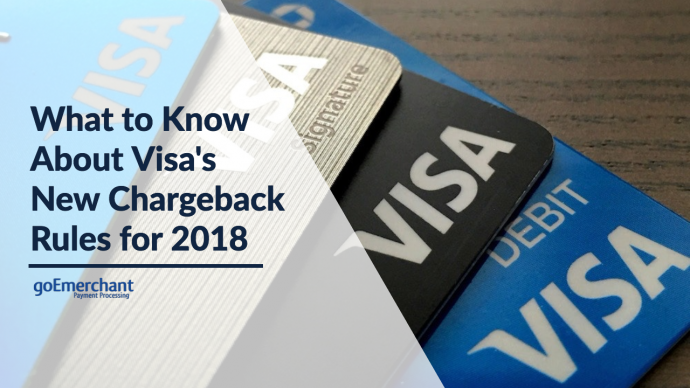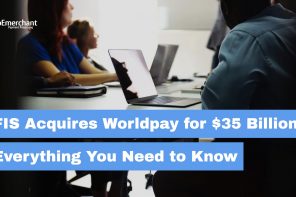Another year, another set of payment rules for merchants. This year, it’s all about Visa’s new chargeback rules, which go into effect in April of 2018.
These chargeback rules have to do with Visa Claims Resolution (VRC) global dispute process, aimed at streamlining the dispute process by cutting down the time and costs associated with the process itself. This is the first major change in many years, according to Visa, which is why the payment network determined it was time to standardize claims disputes.
At the core of Visa’s new chargeback rules has to do with merchants managing chargebacks, which now fall into four reason code categories: Fraud, authorization, processing errors and consumer disputes. Visa notes that cutting down categories organizes and simplifies the process. Chargeback reason code “transaction not recognized” is one of the most popular categories that is being eliminated with the new rules.
Other Major Changes to Visa’s Chargeback Rules
Merchants must act quicker when responding to an initial chargeback dispute under the new rules, which state the response time must be 30 days instead of the previous 45 days. By 2019, this standard is set to be shorted to 20 days. This shift is being done to lessen the number of chargebacks a merchant receives, and reduce the number of invalid disputes.
The arbitration process is also getting shorter for each dispute category. The changes are as follows:
- For authorization and fraud chargeback disputes, the timeline will be 31-70 days.
- For customer disputes and processing errors, the timeframe will be 31-100 days.
- This shift is changed from the previous arbitration deadline of up to 150 days.
The dispute limit deadline for e-commerce transactions is also shifting. The new rules allow issuers to dispute a maximum of 35 transactions during a 120-day period. After 35 transactions, no more disputes can be processed.
Visa Chargeback Rules Dispute Workflow Changes
In general, the new chargeback rules are aimed at simplifying the process. The one area that’s gaining another category is in the dispute workflows, which will have two segments: Allocation and Collaboration. The first being used for fraud, authorization disputes, and automated checks, while the second is used for overseeing the current Visa changes process between issuers, merchants, and acquirers. Here’s a little more about how these workflows operate.
Allocation:
- This process is for fraud and authorization disputes
- This involves Visa performing automated checks to determine if the dispute is 3D Secure verified, whether the transaction was refunded, or if the dispute was filed within the proper time frame.
- The goal of the allocation process is to reduce the number of valid chargebacks
- If a dispute passes through an automated process, the merchant is responsible for the charge, which is why they need to be able to prove the fraud or authorization chargeback claim is insufficient.
Collaboration:
- This process is for processing errors and consumer disputes
- Most disputes will fall under the Allocation workflow
- This workflow process will be similar to what’s done today where each party (merchant, acquirer, and issuer) are part of the process.
- The change comes on the issuer side. They will have to fill out more details than the current workflow process to streamline the communication between the other parties to generate a faster response.
What Visa’s New Chargeback Rules Mean For Merchants
The most significant takeaway for merchants is the number of days they have to respond to a chargeback dispute, which is now being reduced to 30 days. Since that number will drop again next year to 20, merchants will want to get into the habit of responding faster. The goal of this initiative is to reduce the number of chargebacks and make the entire process less lengthy for all parties involved, so disputes are solved quickly and accurately.
Merchants should also be aware of Visa’s new chargeback reason codes, which are now broken down into four categories. Across each of those categories, there are 24 reasons that are now defined under Visa’s new chargeback rules. These rules were initially planned to launch in October 2017 but were pushed back to April 2018.
Below are the new reason code explanations:
| 10. Fraud | 11. Authorization | 12. Processing Errors | 13. Consumer Disputes |
| 10.1 EMV Liability Shift Counterfeit Fraud | 11.1 Card Recovery Bulletin | 12.1 Late Presentment | 13.1 Merchandise/Services Not Received |
| 10.2 EMV Liability Shift Non-Counterfeit Fraud | 11.2 Declined Authorization | 12.2 Incorrect Transaction Code | 13.2 Cancelled Recurring |
| 10.3 Other Fraud – Card Present Environment | 11.3 No Authorization | 12.3 Incorrect Currency | 13.3 Not as Described or Defective Merchandise/Services |
| 10.4 Other Fraud – Card Absent Environment | 2.4 Incorrect Account Number | 13.4 Counterfeit Merchandise | |
| 10.5 Visa Fraud Monitoring Program | 12.5 Incorrect Amount | 13.5 Misrepresentation | |
| 12.6 Duplicate Processing/Paid by Other Means | 13.6 Credit Not Processed | ||
| 12.7 Invalid Data | 13.7 Cancelled Merchandise/Services | ||
| 13.8 Original Credit Transaction Not Accepted | |||
| 13.9 Non-Receipt of Cash or Load Transaction Value |




